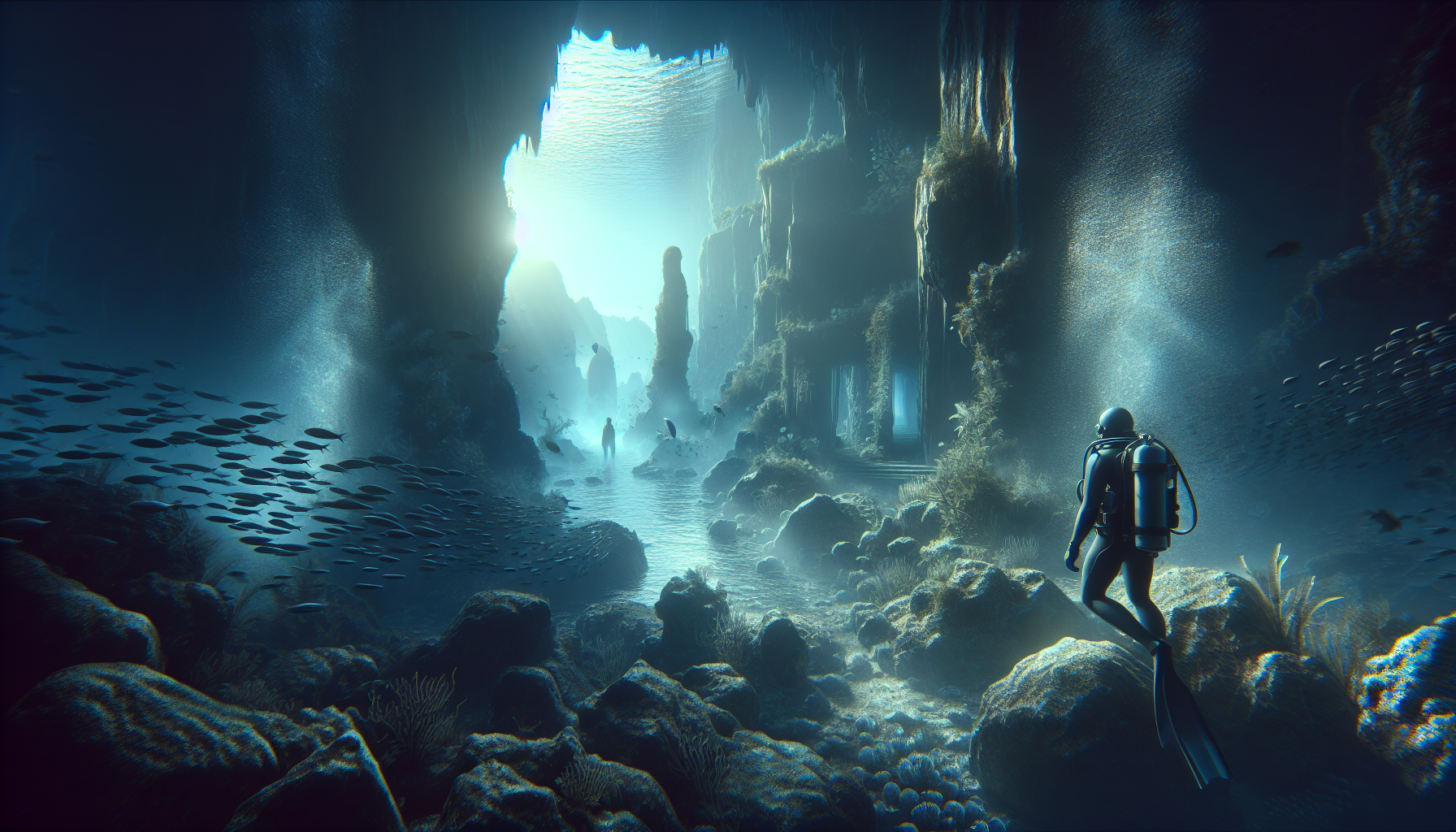In the boundless depths of our planet’s oceans lies a realm so enigmatic and unexplored that it often seems more akin to the cosmic void than to the familiar landscapes above. The mysteries of the deep have fascinated humanity for centuries, inviting a blend of scientific inquiry and imaginative storytelling. Among the most intriguing phenomena of the oceanic underworld are the ethereal echoes that reverberate through its waters. These underwater echoes—acoustic signatures that traverse vast distances—have sparked both scientific curiosity and fertile ground for myths and legends. But what do we really know about these sonic phenomena? Can we sift through the tales of sea monsters and submerged civilizations to uncover the truth? 🌊
In this article, we embark on an immersive journey into the heart of the ocean’s acoustic environment. Our exploration begins with the fundamentals of underwater sound propagation, a complex interplay of physics that transforms the ocean into a vibrant soundscape. We’ll delve into the science behind how sound waves travel through water, influenced by variables such as temperature, salinity, and pressure. Understanding these principles not only unveils the natural symphony beneath the waves but also sets the stage for analyzing the myriad echoes that are captured by researchers. From the haunting songs of whales to the sharp clicks of dolphins, these sounds form a tapestry of communication and survival.
But the story of underwater echoes is not solely one of scientific discovery. Interwoven with factual exploration is a rich tradition of maritime folklore, where reality blurs with the fantastical. As we dissect these tales, we’ll address the long-standing legends of the ocean—from the siren calls that lured sailors to their doom, to the mysterious “bloop” and other unexplained sounds recorded in recent decades. Through a careful examination of these stories alongside modern scientific findings, we aim to separate fact from fiction, revealing the wonders that lie beneath the surface without losing the magic that has inspired generations. Join us as we plunge into the depths, ready to uncover the secrets that the ocean holds in its vast, echoing embrace. 🌌
The Enigmatic World of Underwater Echoes
Underwater echoes have long intrigued scientists and marine enthusiasts alike, offering a fascinating glimpse into the unseen depths of our oceans. These echoes, often resulting from various marine activities and natural phenomena, are critical to our understanding of underwater environments. They help in mapping the seafloor, studying marine life, and even in communication systems used by submarines. Despite their importance, the concept of underwater echoes is often shrouded in mystery, leading to many myths and misconceptions.
When sound travels through water, it behaves differently than it does in air, due to the denser medium. This property is utilized by sonar technology to detect objects and map underwater landscapes. However, the interpretation of these echoes can be complex, as factors such as water temperature, salinity, and depth can alter sound propagation. By analyzing these echoes, scientists can identify fish populations, locate underwater obstacles, and even determine oceanographic conditions. This ability to “see” using sound is invaluable in fields ranging from marine biology to defense.
Despite the technological advances, understanding and interpreting underwater echoes remain a challenging task. The complexity of underwater acoustics means that even the most advanced sonar systems can produce ambiguous data. As researchers work to refine these systems, they often encounter the limitations of current technology, pushing them to innovate and explore new methodologies. This ongoing research is crucial for enhancing our knowledge of the underwater world, ensuring the accurate interpretation of echo data.
Technological Advances in Underwater Echo Interpretation
The advancements in sonar technology have revolutionized the way we study underwater echoes. Modern sonar systems, equipped with advanced signal processing techniques, have become more precise and reliable. These systems use a variety of methods to interpret the echoes they receive, allowing for more accurate mapping of the ocean floor and detection of marine life. The integration of artificial intelligence and machine learning has further enhanced the capability of these systems, enabling them to process large datasets and identify patterns that were previously undetectable.
In recent years, the development of multi-beam sonar systems has been a game-changer. These systems emit multiple sound beams at once, covering a wider area and providing more detailed information. This technology is particularly useful in complex underwater environments, where traditional single-beam systems might struggle to produce clear data. The ability to generate high-resolution maps of the seabed has opened up new possibilities for marine exploration and research.
As we continue to improve our understanding of underwater echoes, the potential applications of this knowledge expand. From improving naval navigation systems to aiding in the conservation of marine ecosystems, the implications are vast. Researchers are also exploring the use of underwater echoes in climate science, using them to study changes in ocean temperature and circulation patterns. This research is crucial for understanding the impacts of climate change on marine environments and developing strategies to mitigate its effects.
Comparison of Sonar Technologies
| Technology | Advantages | Disadvantages |
|---|---|---|
| Single-Beam Sonar | Simple, cost-effective, suitable for shallow waters | Limited coverage, lower resolution |
| Multi-Beam Sonar | High resolution, wide area coverage, detailed mapping | More expensive, complex to operate |
| Side-Scan Sonar | Excellent for detailed imagery, effective in shallow waters | Limited depth penetration, less effective in deep waters |
For a deeper understanding, watch the video below on modern sonar technologies and their applications: Sonar Technology Explained – Tech Vision.
Debunking Myths About Underwater Echoes
Despite the scientific advancements, several myths about underwater echoes persist. These myths often arise from a lack of understanding or sensationalized media reports. For example, one common myth is that underwater echoes can easily identify shipwrecks or lost treasures. While sonar can indeed detect large objects on the seafloor, interpreting these echoes requires expertise and is not as straightforward as it may seem.
Another prevalent myth is that sonar systems can harm marine life, particularly marine mammals. While it’s true that loud noises can disturb or injure marine animals, modern sonar systems are designed to minimize such risks. Researchers and engineers work closely with marine biologists to ensure that sonar technology is used responsibly and that its impact on marine life is carefully monitored. Regulations and guidelines are in place to mitigate potential harm, and ongoing research continues to refine these measures.
Finally, there’s a misconception that underwater echoes are solely used for military purposes. While sonar technology is indeed a vital component of naval operations, its applications extend far beyond defense. Civilian uses of sonar include underwater archaeology, geological research, and even recreational fishing. By understanding the true capabilities and limitations of underwater echoes, we can better appreciate their role in advancing our knowledge of the ocean.
Common Misconceptions and Facts
- Myth: Sonar can always detect underwater objects with pinpoint accuracy.
Fact: Accuracy depends on several factors, including the type of sonar and environmental conditions. - Myth: Underwater echoes can harm marine life indiscriminately.
Fact: Modern systems are designed to reduce impact, and regulations are in place to protect marine ecosystems. - Myth: Sonar is only used for military applications.
Fact: Sonar has numerous civilian applications, from environmental research to commercial fishing.
To explore more about the environmental impact of sonar technology, check out this informative video: The Impact of Sonar on Marine Life – Ocean Science TV.
Future Prospects in the Study of Underwater Echoes
The study of underwater echoes is an evolving field, with exciting prospects on the horizon. As technology continues to advance, we can expect more sophisticated sonar systems that provide even greater insights into the underwater world. The integration of big data analytics and machine learning will likely play a significant role in processing the vast amounts of data generated by these systems, uncovering patterns and insights that were previously hidden.
One promising area of research is the development of autonomous underwater vehicles (AUVs) equipped with advanced sonar systems. These AUVs can operate independently, exploring remote or hazardous areas that are difficult for humans to access. Their ability to collect data over extended periods makes them invaluable tools for long-term studies of marine environments. As AUV technology improves, we can expect more detailed and comprehensive maps of the ocean floor, leading to new discoveries and insights.
The potential applications of underwater echo research are vast and varied. From enhancing maritime safety to advancing our understanding of ocean ecosystems, the possibilities are endless. As we continue to explore the depths of our oceans, the study of underwater echoes will remain a crucial tool in our quest to uncover the mysteries of the deep. By embracing new technologies and methodologies, we can look forward to a future where our understanding of the underwater world is more comprehensive and accurate than ever before.
Emerging Technologies in Underwater Exploration
| Technology | Potential Benefits |
|---|---|
| Autonomous Underwater Vehicles (AUVs) | Extended exploration capabilities, data collection in remote areas |
| Machine Learning Algorithms | Enhanced data processing, pattern recognition |
| Advanced Sonar Systems | Improved accuracy, wider application range |
Stay informed about the latest developments in underwater technology by watching this video on future prospects in sonar research: Future of Sonar Technology – Innovations Ahead – Tech Insight.

Conclusion
Conclusion: Uncovering the Mysteries of Underwater Echoes
In the journey to explore the enigmatic world of underwater echoes, we have ventured into the depths of scientific inquiry and human curiosity. The ocean, with its vast expanse and hidden realms, offers a symphony of sounds that echo through its waters, providing us with invaluable insights into its mysteries. This exploration has not only enriched our understanding of marine acoustics but also highlighted the delicate balance between scientific discovery and the myths that often surround it.
Throughout this article, we delved into the fundamentals of underwater acoustics, unraveling how sound travels through water and how these echoes can reveal so much about the underwater world. From the basic principles of sound propagation in water to the advanced technologies used in sonar and underwater communication, we’ve touched upon the pivotal elements that enable scientists to map ocean floors, study marine life, and even detect distant seismic activities.
We’ve also addressed the fascinating history of how human interpretations of underwater sounds have evolved. From ancient seafarers who spun tales of mythical sea creatures to modern scientists who utilize precise instruments to decode the language of the sea, our perception of these echoes has been a blend of fact and fiction. This evolution underscores the importance of maintaining a critical yet open-minded approach to scientific exploration.
The discussion also extended to the role of technology in separating fact from fiction. Modern advancements have equipped us with sophisticated tools that can distinguish between natural underwater phenomena and man-made noises. These tools are crucial not only for scientific research but also for practical applications such as submarine navigation and marine conservation efforts. By leveraging these technologies, we are better equipped to preserve marine ecosystems and ensure the sustainable use of ocean resources.
Moreover, we touched upon the cultural and environmental implications of underwater sounds. The ocean’s soundscape is not just a subject of scientific interest; it plays a crucial role in the lives of marine creatures and, by extension, the health of our planet. Understanding and respecting this soundscape is essential for preserving biodiversity and maintaining ecological balance. As such, responsible practices in marine industries and proactive conservation policies are vital.
In synthesizing these points, it becomes clear that the study of underwater echoes is a field rich with potential and significance. The ocean, with its endless mysteries, continues to challenge and inspire us. It beckons us to listen closely, to learn more, and to act wisely. Whether you are a scientist, an enthusiast, or a casual reader, the call of the ocean is one that invites all of us to explore further, ask questions, and share what we learn.
The importance of this topic cannot be overstated. The health of our oceans is intrinsically linked to the health of our planet. By deepening our understanding of underwater acoustics, we contribute to broader efforts to protect and sustain our marine environments. This is a call to action for everyone. Whether through sharing this knowledge, participating in conservation efforts, or simply fostering a deeper appreciation for the ocean, each of us has a role to play.
I invite you, dear reader, to reflect on what you’ve learned and consider how you might apply it. Perhaps you are inspired to support oceanic research initiatives, or maybe you will become more mindful of the environmental impact of underwater noise pollution. Whatever your takeaway, know that your engagement matters.
Feel free to comment below with your thoughts, questions, or insights. Let’s continue this conversation and expand our collective understanding. Share this article with others who might be intrigued by the mysteries of underwater echoes. Together, we can spread awareness and inspire action.
As we close this chapter of exploration, remember that the ocean’s whispers are more than mere echoes; they are stories waiting to be told, knowledge waiting to be uncovered, and a reminder of the wonders that lie beneath the waves. 🌊
For further reading and exploration, consider visiting these resources:
1. [NOAA Ocean Explorer](https://oceanexplorer.noaa.gov)
2. [National Geographic Oceans](https://www.nationalgeographic.com/environment/oceans)
3. [The Ocean Conservancy](https://oceanconservancy.org)
Let us listen, learn, and lead with curiosity and care for our oceans and their myriad mysteries.
Toni Santos is a sound storyteller and folklore researcher whose creative path bridges the mystical and the biological through the lens of bioacoustic folklore. With an ear attuned to the voices of nature, Toni explores how ancient cultures interpreted birdsong, forest echoes, and animal calls—not as noise, but as messages, omens, and myths encoded in sound.
Rooted in a passion for both natural science and ancestral lore, his work uncovers the forgotten connections between ecosystems and oral traditions. From the whispered warnings in owl cries to the songs of frogs heralding rain, Toni’s narratives evoke a time when humans listened to nature with reverence and meaning.
Drawing on a background in ecological arts and auditory storytelling, Toni merges field recordings with mythic imagery, turning natural sounds into cultural artifacts of wonder. His stories do more than entertain—they restore a way of hearing the world that blends intuition, memory, and deep listening.
As the creative force behind Vizovex, Toni offers sonic tales, symbolic soundscapes, and research-based reflections that help others rediscover the sacred language of the wild.
His work is a tribute to:
The mythological significance of animal and elemental sounds
Ancient practices of listening for meaning in nature
The spiritual dialogue between humans and soundscapes
Whether you’re a folklorist, an acoustic ecologist, or a curious listener, Toni invites you into a world where the forest speaks, and every chirp, croak, and howl carries a story—one echo, one legend, one call at a time.



